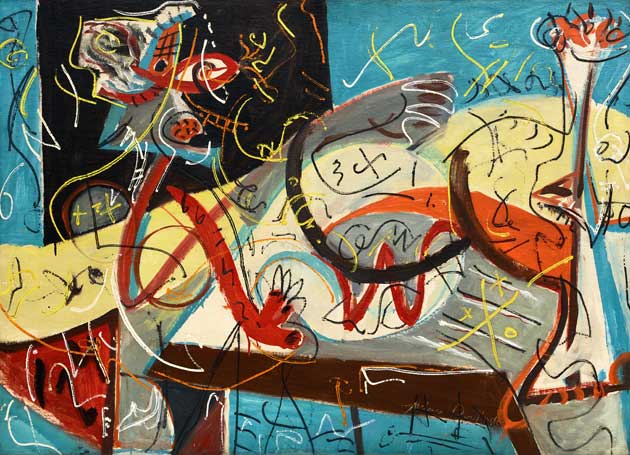Great Works: Stenographic figure (1942), Jaskson Pollock
Museum Of Modern Art, New York

Modern art kept comedy at bay. It had good reason to. People were always poking fun at it, and calling it a joke, and accusing the artists of playing a prank on the public. Modern artists had to be careful not to give too many hostages to this line of attack.
There was also a clear likeness between modernist distortions and traditional comic art. A lot of 20th-century art echoed the vocabulary of cartoon and caricature. But it shouldn't be equated with such low cultural activities.
That's certainly what we're taught. Modern art's comic aspect is repressed. What look like funny figures aren't really funny. They are pure formal experiments, or acts of violence, or deeply disturbing. Anything to keep them on the right side of straight.
And surely nobody would turn to the New York Abstract Expressionists for a laugh. They're the apostles of heroic agony, serene spirituality, apocalyptic fire. Yet one of those artists has one big funny moment: Jackson Pollock.
In the early 1940s, Pollock aspired to be an artist of high seriousness. He was drawn to "automatic writing", used by the Surrealists to access their deep unconscious. He was using Jungian symbols and runes, archetypal, mythic and ritual elements.
But then there is Stenographic Figure. It was a breakthrough work. Piet Mondrian, the great Dutch abstract painter, was in war exile in the US and scouting for the patroness Peggy Guggenheim. He noticed and commended the piece. "I have the feeling that this may be the most exciting painting I have seen in a long, long time, here or in Europe."
Mondrian had rightly spotted something unusual. There was "the im-pression of tremendous energy" that looked forward to the famous drip paintings. But there was something else, something not followed up. It's the only comic picture from Pollock's hand.
Stenographic Figure? This is presumably not an office scene. The artist implies that he's taking dictation from his unconscious. Yet it is a figurative picture. It seems to have two figures in it, even though the title says only one. They are, in effect, stick figures, made up of coiling lines. They're very loosely constructed, but with heads and arms and bodies.
The one at right is seen in profile, with its hand put down. The one at left appears face on, with its hand flipped up. They meet across a table, or across a bed, and are engaged in some passionate confrontation. All is energy, speed, spontaneity. Anatomy is action. The looping gesticulations of the pair arise directly from the painter's looping gestures.
The space around them, meanwhile, is swarming with graphic mayhem. It's as if their speech balloons or thought bubbles had burst, and spilt out all their contents. Bits of writing take flight, flicker in the air, judder and collide. In the process they lose their regular shapes. Free-form glyphs, sudden squiggles and shudder lines – plus some letters, numbers and signs, too – crowd about the loopy figures.
And loopy is the word. It's a term that connects shape and madness (though whether this half-jokey phrase is meant to imply flailing physical motions, or the irrational circles of the mind, is another matter). Loopiness characterises the pair. It's not the only such expression at work. Twisted could be another. The language of mental trouble uses many visual metaphors, and this picture is alive with them.
Scatter-brained, for example, is an obvious term, or scatty, applying well to the cyphers scattered around the figures. Haywire, likewise, is a good one, since those jumpy marks look like strands of hay and wire. Or again, because of their resemblance to electrical activity, or to lightning strokes, these squiggles can point towards brainstorm.
There's also the possibly significant fact that, in English, several common words for the wild mind are drawn to the letter "z": crazy, zany, dizzy, buzzing. The zigzag letter is a designed for this role, with its switchback action. Zigzags turn up all over Stenographic Figure. It is another, subliminal indication of derangement.
Now you may suspect that this is reading too much in. You may wonder how many of these effects the artist himself could have been conscious or indeed "unconscious" of.
And you may find especially dubious the idea that lurking verbal metaphors, and the secret power of the letter "z", are making the going in this semi-abstract picture.
But these associations arise easily from the imagery. Loops, twists, scatters, squiggles, zigzags, storms and so on – you may or may not choose to translate these visual forms into verbal terms, but the translation is natural enough. Visual or verbal, this is the language that Stenographic Figure uses, and what gives it its sense of craziness.
It's a laughable craziness. The comedy isn't strange. It comes from the bouncy, doodly lines of the critters and glyphs. It comes from the clear presence of funny faces – the profile head with its anxious bug-eye and its fishlike-nose, and the face-on head with its gleeful vacant smile.
This figure delivers a casual gesture of insult, or maybe a cuff, and its body zooms straight up like an exclam- ation mark.
Stenographic Figure performs in an undeniably cartoony register. And – doolally, skewiff – it takes the cartoon into a world it has never revisited. Pollock's work holds here a possibility that still waits to be realised.
Subscribe to Independent Premium to bookmark this article
Want to bookmark your favourite articles and stories to read or reference later? Start your Independent Premium subscription today.

Join our commenting forum
Join thought-provoking conversations, follow other Independent readers and see their replies